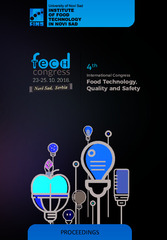Prikaz osnovnih podataka o dokumentu
Fruit traits, capsaicin and dihydrocapsaicin content in some Serbian hot peppers
| dc.creator | Danojević, Dario | |
| dc.creator | Zeremski, Tijana | |
| dc.creator | Stojanov, Nadežda | |
| dc.creator | Medić-Pap, Slađana | |
| dc.creator | Gvozdanović-Varga, Jelica | |
| dc.creator | Červenski, Janko | |
| dc.date.accessioned | 2022-03-30T07:33:50Z | |
| dc.date.available | 2022-03-30T07:33:50Z | |
| dc.date.issued | 2018 | |
| dc.identifier.isbn | 978-86-7994-056-8 | |
| dc.identifier.uri | http://fiver.ifvcns.rs/handle/123456789/2554 | |
| dc.description.abstract | The diversity of fruit traits and pungency level in hot pepper (Capsicum annuum L.) are very important for consumers. Therefore the aim of this study was to evaluate phenotypic fruit traits and content of capsaicin and dihydrocapsaicin in nine hot pepper genotypes (five varieties and four breeding lines) originating from Serbia. A field trial was conducted on chernozem soil in 2017 at the Institute of Field and Vegetable Crops (IFVCNS) in Novi Sad, Serbia. The experiment was established in a randomized block design with two replications and 20 plants per replicate. Six quantitative fruit traits (weight, length, diameter, index, pericarp thickness, and total soluble solids) were used for fruit characterization. Ten fruits in technological maturity were analysed per genotype, and dried. The sample of each dry pepper was ground and 1 g was prepared for capsaicin and dihydrocapsaicin analysis into GC-MS. The pungency levels were calculated in Scoville heat units. The longest fruits (22.12 cm and 19.80 cm) had breeding lines 243/17 and 238/17 respectively, while the fruit length of other genotypes ranged from 6.15 to 15.83 cm. Variety Somborka had the highest pericarp thickness and fruit weight. Total soluble solids (TSS) in all genotypes varied between 4.12 - 8.16 °Brix, however, the highest TSS were noted in three genotypes which belong to small pepperoni fruit type. According to performed analysis, the lowest capsaicin and dihydrocapsaicin contents were measured in Somborka variety, while the new variety NS Vatrena had the highest dihydrocapsaicin content and pungency. | sr |
| dc.language.iso | en | sr |
| dc.publisher | Novi Sad : University of Novi Sad, Institute of Food Technology | sr |
| dc.relation | info:eu-repo/grantAgreement/MESTD/Technological Development (TD or TR)/31030/RS// | sr |
| dc.rights | openAccess | sr |
| dc.rights.uri | https://creativecommons.org/licenses/by/4.0/ | |
| dc.source | Proceedings, 4th International Congress “Food Technology, Quality and Safety” Food Tech Congress, 23-25 October 2018, Novi Sad, Serbia | sr |
| dc.subject | Capsicum | sr |
| dc.subject | Capsaicin | sr |
| dc.subject | Scoville Heat Unit | sr |
| dc.subject | Serbia | sr |
| dc.subject | hot peppers | sr |
| dc.subject | fruit traits | sr |
| dc.subject | genotypes | sr |
| dc.subject | pungency | sr |
| dc.title | Fruit traits, capsaicin and dihydrocapsaicin content in some Serbian hot peppers | sr |
| dc.type | conferenceObject | sr |
| dc.rights.license | BY | sr |
| dc.citation.epage | 426 | |
| dc.citation.spage | 420 | |
| dc.identifier.fulltext | http://fiver.ifvcns.rs/bitstream/id/7039/bitstream_7039.pdf | |
| dc.identifier.rcub | https://hdl.handle.net/21.15107/rcub_fiver_2554 | |
| dc.type.version | publishedVersion | sr |


